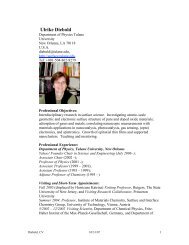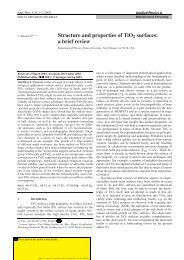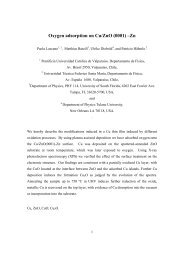The surface science of titanium dioxide - Niser
The surface science of titanium dioxide - Niser
The surface science of titanium dioxide - Niser
Create successful ePaper yourself
Turn your PDF publications into a flip-book with our unique Google optimized e-Paper software.
90 U. Diebold / Surface Science Reports 48 (2003) 53±229<br />
Fig. 19. STM images …500 Ð 500 І <strong>of</strong> a TiO 2 (1 1 0) <strong>surface</strong> taken at room temperature. 18 O 2 (1 10 6 mbar) was dosed<br />
at (a) 500 K, (b) 520 K, (c) 550 K, (d) 660 K for 10 min, (e) 710 K for 15 min, and (f) 830 K for 20 min. Before each gas<br />
exposure, the sample was sputtered and annealed in UHV at 880 K for 30 min which renders ¯at, (1 1)-terminated <strong>surface</strong>s.<br />
From Li et al. [75]. # 1999 Elsevier.<br />
`age' or color) <strong>of</strong> the crystal. <strong>The</strong>se parameters have been investigated in detail by Li et al.<br />
[75,144,156,170,171]. For example, Fig. 19 shows the effect <strong>of</strong> annealing in 1 10 6 mbar O 2 at<br />
various temperatures [75]. Before each gas exposure, a ¯at (1 1)-terminated <strong>surface</strong> was prepared by<br />
sputtering and annealing in UHV. <strong>The</strong> <strong>surface</strong> morphology<strong>of</strong> the oxygen-exposed sample is very<br />
temperature dependent. For medium temperatures, <strong>surface</strong>s are relativelyrough with manysmall-scale<br />
features. Isotopicallylabeled 18 O 2 gas was used for the annealing excursions. In SSIMS and low-energy<br />
He ‡ ion scattering measurements, the signal from 18 O atoms can clearlybe separated from the<br />
(naturallymuch more common) 16 O isotope in the crystal. All the <strong>surface</strong>s in Fig. 19 showed an<br />
enrichment with 18 O, with a maximum <strong>of</strong> 18 O <strong>surface</strong> concentration around 660 K. <strong>The</strong> structures that<br />
form for intermediate annealing temperatures (520±660 K) are better seen in the small-scale image in<br />
Fig. 20. <strong>The</strong>yconsist <strong>of</strong> small, (1 1)-terminated islands and irregular networks <strong>of</strong> connected<br />
`rosettes', i.e., six bright spots in a pseudohexagonal arrangement, as well as small strands. A model for<br />
the rosette network is shown in Fig. 21. It consists <strong>of</strong> atoms in bulk-like positions with some atoms<br />
missing from the regular (1 1) structure. LDA-based ®rst-principles calculations [75] showed that<br />
such a rosette structure is stable. <strong>The</strong> same calculations also predict sizable relaxations.







